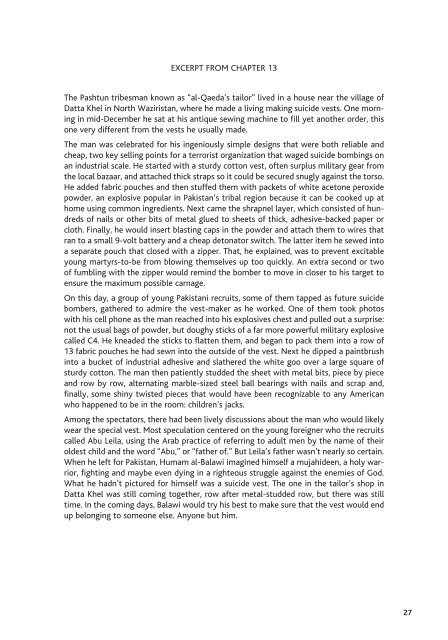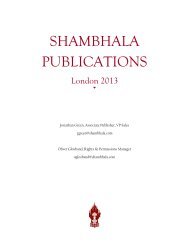Create successful ePaper yourself
Turn your PDF publications into a flip-book with our unique Google optimized e-Paper software.
EXCERPT FROM CHAPTER 13<br />
<strong>The</strong> Pashtun tribesman known as “al-Qaeda’s tailor” lived in a house near the village of<br />
Datta Khel in North Waziristan, where he made a living making suicide vests. One morning<br />
in mid-December he sat at his antique sewing machine to fill yet another order, this<br />
one very different from the vests he usually made.<br />
<strong>The</strong> man was celebrated for his ingeniously simple designs that were both reliable and<br />
cheap, two key selling points for a terrorist organization that waged suicide bombings on<br />
an industrial scale. He started with a sturdy cotton vest, often surplus military gear from<br />
the local bazaar, and attached thick straps so it could be secured snugly against the torso.<br />
He added fabric pouches and then stuffed them with packets of white acetone peroxide<br />
powder, an explosive popular in Pakistan’s tribal region because it can be cooked up at<br />
home using common ingredients. Next came the shrapnel layer, which consisted of hundreds<br />
of nails or other bits of metal glued to sheets of thick, adhesive-backed paper or<br />
cloth. Finally, he would insert blasting caps in the powder and attach them to wires that<br />
ran to a small 9-volt battery and a cheap detonator switch. <strong>The</strong> latter item he sewed into<br />
a separate pouch that closed with a zipper. That, he explained, was to prevent excitable<br />
young martyrs-to-be from blowing themselves up too quickly. An extra second or two<br />
of fumbling with the zipper would remind the bomber to move in closer to his target to<br />
ensure the maximum possible carnage.<br />
On this day, a group of young Pakistani recruits, some of them tapped as future suicide<br />
bombers, gathered to admire the vest-maker as he worked. One of them took photos<br />
with his cell phone as the man reached into his explosives chest and pulled out a surprise:<br />
not the usual bags of powder, but doughy sticks of a far more powerful military explosive<br />
called C4. He kneaded the sticks to flatten them, and began to pack them into a row of<br />
13 fabric pouches he had sewn into the outside of the vest. Next he dipped a paintbrush<br />
into a bucket of industrial adhesive and slathered the white goo over a large square of<br />
sturdy cotton. <strong>The</strong> man then patiently studded the sheet with metal bits, piece by piece<br />
and row by row, alternating marble-sized steel ball bearings with nails and scrap and,<br />
finally, some shiny twisted pieces that would have been recognizable to any American<br />
who happened to be in the room: children’s jacks.<br />
Among the spectators, there had been lively discussions about the man who would likely<br />
wear the special vest. Most speculation centered on the young foreigner who the recruits<br />
called Abu Leila, using the Arab practice of referring to adult men by the name of their<br />
oldest child and the word “Abu,” or “father of.” But Leila’s father wasn’t nearly so certain.<br />
When he left for Pakistan, Humam al-Balawi imagined himself a mujahideen, a holy warrior,<br />
fighting and maybe even dying in a righteous struggle against the enemies of God.<br />
What he hadn’t pictured for himself was a suicide vest. <strong>The</strong> one in the tailor’s shop in<br />
Datta Khel was still coming together, row after metal-studded row, but there was still<br />
time. In the coming days, Balawi would try his best to make sure that the vest would end<br />
up belonging to someone else. Anyone but him.<br />
27






